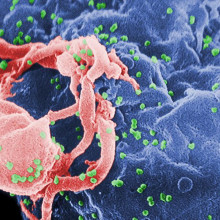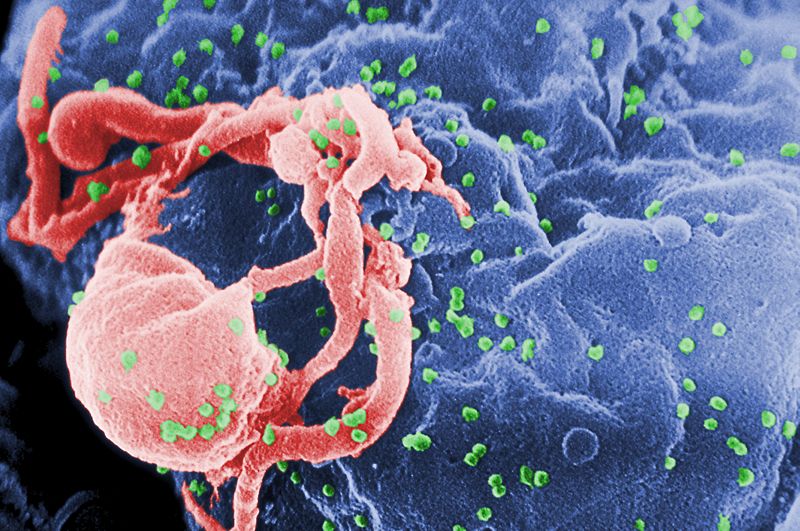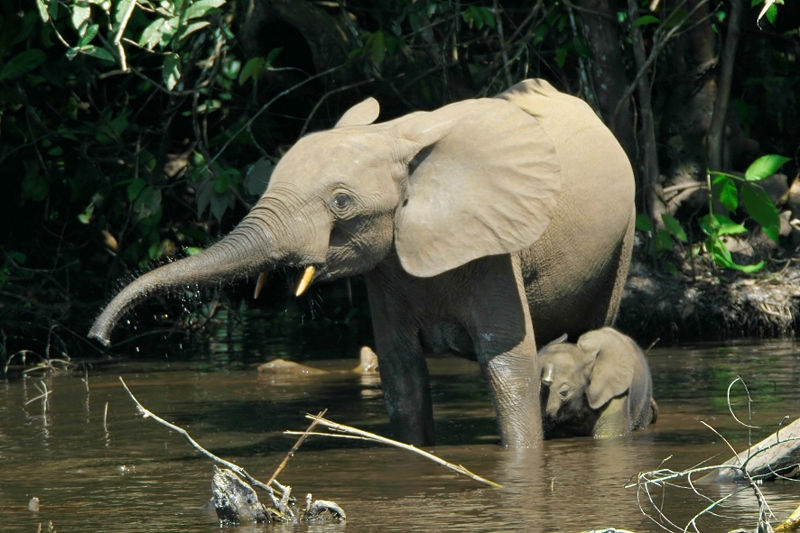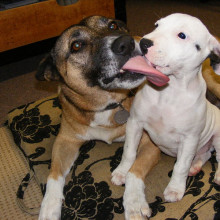On this week's NewsFlash, we find out why some people are genetically pre-disposed to AIDS, how the giardia bug changes coats to trick the immune system and why captive elephants live shorter lives than in the wild. Plus, why dogs get jealous, and how to lose a satellite!
In this episode

Genetic predisposition to AIDS
Some people might be genetically pre-disposed to developed more severe consequences of AIDS infections, new research has found.
 Writing in the journal AIDS, Stephen O'Brien and his colleagues at the National Cancer Institute, Maryland, sequenced the mitochondrial DNA from 1833 patients infected with HIV in the 1980s before anti-retroviral drugs became available. By comparing the genetic data with the time each of the patients took to develop AIDS the team were able to identify certain genetic signatures linked to progression of the disease. The results could be used prognostically in future to inform HIV-infected patients of their likely outcome.
Writing in the journal AIDS, Stephen O'Brien and his colleagues at the National Cancer Institute, Maryland, sequenced the mitochondrial DNA from 1833 patients infected with HIV in the 1980s before anti-retroviral drugs became available. By comparing the genetic data with the time each of the patients took to develop AIDS the team were able to identify certain genetic signatures linked to progression of the disease. The results could be used prognostically in future to inform HIV-infected patients of their likely outcome.
At the same time, understanding the mechanism that makes some people more susceptible than others may also help to highlight novel approaches to treatment.

Getting personal with breast cancer treatment
It's becoming increasingly clear that the old saying "one size fits all" doesn't work when it comes to cancer treatment. The more scientists discover about the genetic faults that underpin different tumours, the more it's possible to divide them into sub-types, which may in turn respond very differently to treatment. A good example of this is the breast cancer drug Herceptin, which only works for patients whose tumours have high levels of a molecule called HER2.
 Now scientists in Edinburgh funded by Cancer Research UK have made an important discovery which could help to improve tailored treatment for breast cancer. They've found that a genetic test that's already used in breast cancer patients can predict whether an individual will benefit from certain drugs or not. And we could see it become standard clinical practice within a couple of years.
Now scientists in Edinburgh funded by Cancer Research UK have made an important discovery which could help to improve tailored treatment for breast cancer. They've found that a genetic test that's already used in breast cancer patients can predict whether an individual will benefit from certain drugs or not. And we could see it become standard clinical practice within a couple of years.
The drugs in question are anthracyclines, including one called epirubicin. Epirubicin as an effective drug for breast cancer, but it only works in a certain proportion of patients. But because it can cause quite bad side effects, and it doesn't work for all patients who get it, its use in the clinic has been limited.
So Professor John Bartlett and his team looked at tumour samples from more than 2,500 women who were on clinical trials of epirubicin, to find out if they could identify genetic markers in their cancers that would predict whether they did or didn't respond to the treatment.
In the end, they found that women who had extra copies of chromosome 17 were likely to respond to the treatment. But women with the normal number - that's two copies - were less likely to respond.
And here's where it gets interesting. This extra dosage of chromosome 17 is already known to be involved in breast cancer, because this is the region of the genome that harbour HER2. So there's already an effective test to look for duplications of the chromosome, which is routinely used by doctors to find out if a woman will benefit from Herceptin treatment.
The team are still waiting for the results of one final clinical trial to confirm the accuracy of the test. But if all goes well, we should see this becoming clinical practice within a year or two.
Giardia Gene Shuffling Masks Bug from Immunity
A common gut bug has evolved an ingenious strategy to outwit the immune system, helping to conceal the parasite from immune attack.
 Writing in this week's Nature an Argentinian research team led by Hugo Lujan at the Catholic University at Cardoba found that Giardia lamblia, a major cause of intestinal infections worldwide, has a repertoire of 190 different coat proteins with which it can disguise itself. The organism selects a different coat every few generations, returning the previous outfit to the genomic wardrobe to wear again in the future.
Writing in this week's Nature an Argentinian research team led by Hugo Lujan at the Catholic University at Cardoba found that Giardia lamblia, a major cause of intestinal infections worldwide, has a repertoire of 190 different coat proteins with which it can disguise itself. The organism selects a different coat every few generations, returning the previous outfit to the genomic wardrobe to wear again in the future.
By studying which genes were being turned on in Giardia the researchers found that the parasite uses a mechanism called RNA interference to suppress the action of the other 189 coat genes it's not using. The bug makes short sequences of the DNA-relative RNA, which are the genetic mirror-image of the un-used coat genes. These mirror-image RNAs lock on to their respective coat genes and prevent them from being expressed, keeping them in the closet.
Exactly how the outfit subsequently gets reshuffled to select a different coat remains a mystery, but the team suspect that chemical tags applied to the DNA, called epigenetic markers, could be responsible. Either way, understanding this system will inevitably lead to new ways to combat the bug, which spreads via contaminated water and infects millions of people, worldwide, each year.

Zoo life not so good for elephants
Everybody loves elephants, and they're often a big attraction in any zoo. But some rather sad news in this week's edition of the journal Science suggests that zoo life my not be all that good for them.
 Researchers from the RSPCA, along with other colleagues, did a survey of nearly 800 elephants living in zoos, and compared them to around 3,000 elephnts who either lived wild in Amboseli National Park in Kenya, or were working with loggers in Burma.
Researchers from the RSPCA, along with other colleagues, did a survey of nearly 800 elephants living in zoos, and compared them to around 3,000 elephnts who either lived wild in Amboseli National Park in Kenya, or were working with loggers in Burma.
The results of the -ahem - mammoth survey were shocking. The African elephants in the National Park lived for around 56 years, and even those that were poached or killed by humans lived and average of 36. But African elephants in zoos only made it to an average of 17. And we know this is because adults are dying younger, and the death rates among baby and young elephants were the same across the populations.
Looking at Asian elephants, the team found the same thing. The logging elephants in Burma made it to an average of 42 years old, compared with Asian elephants in zoos that lived to an average of just 19. But in this case, most of the difference was due to higher death rates among newborn baby elephants in zoos, rather than adults dying younger. The researchers think this my be due to traumatic events while the babies are still in the womb, as Asian elephants that are born wild but then captured for zoos live longer on average than those born in captivity.
So what's causing the difference? The RSPCA believe that zoo life causes the elephants stress and obesity, which affects their lifespan. And diseases such as herpes, and tuberculosis, as well as lameness and infertility play a part. The researchers also point the finger at the stress that happens when animals are transferred between zoos - especially when this involves separating mothers and calves.
Although it's causing controversy in the world of zookeepers, this study highlights the fact that more needs to be done for the welfare of zoo elephants. And maybe we should ask if they should be kept in zoos at all.

Paws for thought - dogs demonstrate envy!
Scientists have found that just like humans and other primates, dogs get jealous too!
 The Austrian team paired up pooches and asked the dogs to hold out a paw on demand from the handlers. One of the dogs was given a treat whenever it cooperated, the other dog went unrewarded. Quite quickly the un-treated dogs detected the inequality and refused to cooperate further. That this was down to jealousy was suggested by the fact that when the dogs were tested on their own - i.e. without a second dog being rewarded alongside them - they continued to cooperate despite the absence of any treat.
The Austrian team paired up pooches and asked the dogs to hold out a paw on demand from the handlers. One of the dogs was given a treat whenever it cooperated, the other dog went unrewarded. Quite quickly the un-treated dogs detected the inequality and refused to cooperate further. That this was down to jealousy was suggested by the fact that when the dogs were tested on their own - i.e. without a second dog being rewarded alongside them - they continued to cooperate despite the absence of any treat.
"This shows that dogs have the same basic brain programming for inequity that we do," says study author Friedericke Range, "although it is probably better developed in higher animals like primates that also gauge the size rather than just the sheer physical presences of a reward."
The team suggest that the result is an evolutionary mechanism for fostering cooperation between pack and social animals like dogs, wolves and monkeys. "When you see that someone doing the same work as you is getting more reward it makes sense to refuse to cooperate until equality is restored," says Range.
Related Content
- Previous Tryptophan and Turkey
- Next Emerging Diseases










Comments
Add a comment